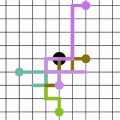This paper proposes 12 multi-object grasps (MOGs) types from a human and robot grasping data set. The grasp types are then analyzed and organized into a MOG taxonomy. This paper first presents three MOG data collection setups: a human finger tracking setup for multi-object grasping demonstrations, a real system with Barretthand, UR5e arm, and a MOG algorithm, a simulation system with the same settings as the real system. Then the paper describes a novel stochastic grasping routine designed based on a biased random walk to explore the robotic hand's configuration space for feasible MOGs. Based on observations in both the human demonstrations and robotic MOG solutions, this paper proposes 12 MOG types in two groups: shape-based types and function-based types. The new MOG types are compared using six characteristics and then compiled into a taxonomy. This paper then introduces the observed MOG type combinations and shows examples of 16 different combinations.
翻译:本文从人和机器人掌握的数据集中提出12种多物体抓取(MOGs)类型。 抓取类型随后经过分析, 组织成一个MOG分类。 本文首先介绍三个MOG数据收集组: 多物体抓取演示的人体手指追踪装置、 巴雷特汉、 UR5e 臂和 MOG 算法的真系统、 模拟系统, 模拟系统与实际系统相同。 然后, 本文描述了一种新颖的随机抓取程序, 以有偏向的随机行走为基础, 用于探索机器人手的配置空间, 用于可行的MOGs 。 根据对人类演示和机器人的MOG 解决方案的观察, 本文提出12种MOG 类型分为两类: 基于形状的类型和基于功能的类型。 新的MOG类型使用6个特性进行比较, 然后汇编成一个分类系统。 本文随后介绍了观察到的MOG 类型组合, 并展示了16种不同组合的实例 。




